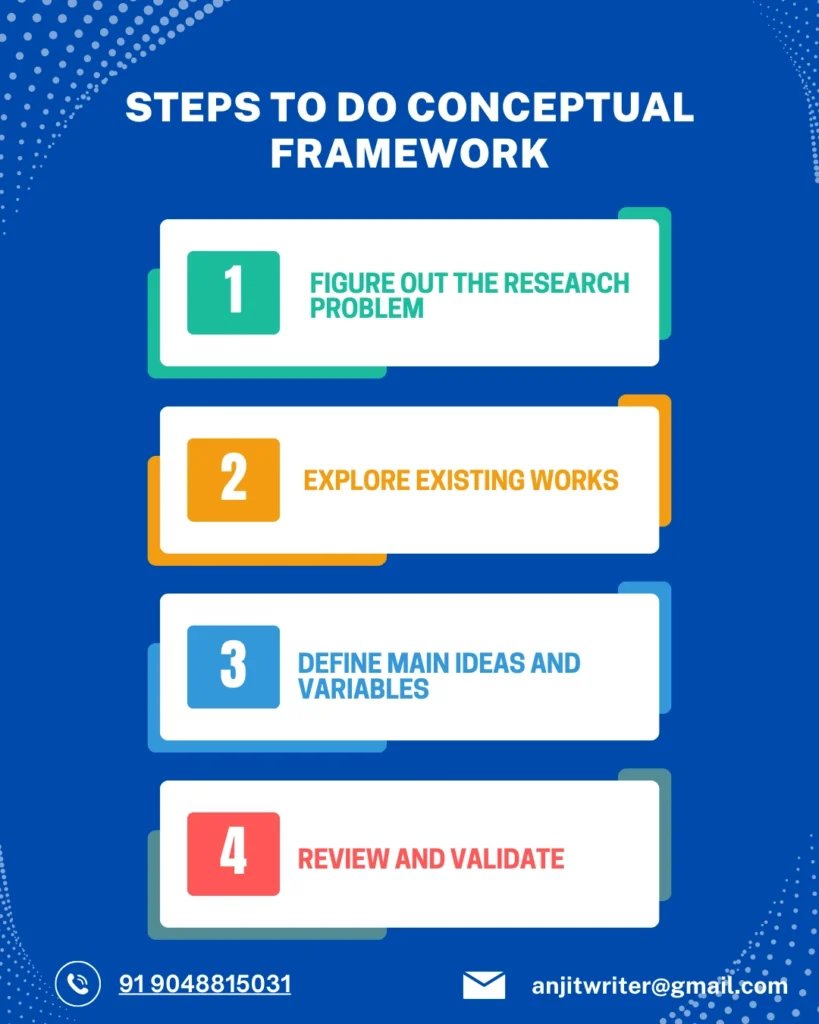Have you ever found yourself in a perplexed state of mind about your research with no clear structure? You are among thousands of students who haven’t prepared a conceptual framework for their research. If you have a well-crafted conceptual framework for your academic paper, it can give your study a proper direction and clarity. In this guide, we are going to break it down in simple terms with conceptual framework examples so you can confidently create one for your research. Let’s get started!
What are Frameworks in Research?
In academic research, a framework means a structure that helps you bridge research gaps and guides your study by organizing ideas, variables, and relationships. In other words, it gives you a direction for your paper and clarity for the topic you are dealing with. There are two types of frameworks in research – a theoretical framework and a conceptual framework. The former uses existing theories to support the research. The latter uses a conceptual framework, which defines key concepts and their connections. Both frameworks play a very important role in enhancing the understanding and focus of research.
What are Conceptual Frameworks in Research?
When you conduct research for a thesis or dissertation, you are likely to encounter gaps. These gaps are essential to be addressed or bridged in order to complete the research by building on the existing foundation that the current research has left. The framework establishes the direction or roadmap for the research by listing out the objectives, priorities and showing how the variables are interconnected.
Read More:
| Dissertation Topics | MBA Dissertation Topics | Nursing Dissertation Topics |
| Law Dissertation Topics | HistoryDissertation Topics | Psychology Dissertation Topics |
What Is the Purpose and Significance of a Conceptual Framework in Research?
A conceptual framework serves the purpose of providing a structured foundation for your research. It does this by defining the key concepts you are touching and their mutual relationships. Its significance lies in guiding the study’s direction. When there is a clear roadmap, it is easy to achieve coherence and ensure validity for the findings. Consequently, you will have a more organized, meaningful, and impactful project.
Difference Between Conceptual Framework and Theoretical Framework in Research
| CONCEPTUAL FRAMEWORK | THEORETICAL FRAMEWORK |
| It is a synopsis by the researcher about the ideas and concepts dealt with in the research. | It offers insights into the theories that are currently available on a research topic, which the researcher can use as the foundation. |
| Suitable for studies where new concepts or relationships are essential to discover. | Suitable for research topics which need to rely vastly on existing theories. |
| The purpose of the conceptual framework model is to explain variables and their connection, and thereby set structure for the study. | While both conceptual and theoretical frameworks are used in research, the latter is essential to explain a phenomenon through a theoretical lens. |
| Conceptual framework for thesis relies on the researcher’s insights, previous studies and insights as sources. | Theoretical framework solely depends on well-established theories in the domain or research topic. |
| There is a greater level of flexibility for creating conceptual framework. | Unlike the conceptual framework example in research, the theoretical framework is more rigid in nature |
What You Should Try to Include in a Conceptual Framework?
Having reviewed the conceptual framework definition, let’s see what it includes. A conceptual framework for quantitative research includes critical process elements, causal connections and specified variables. During its development, a researcher should prioritize coming up with high-quality questions and their solutions. By doing so, they can keep the research in the right order from the very start and facilitate the process of deriving appropriate insights.
How To Do Conceptual Framework?
Making a conceptual framework for research is one of the most important steps every student should carefully plan and develop. Here are the easiest steps you can follow to do it effectively.

Step 1: Figure Out Your Research Problem/Question:
Start by pinpointing the core issue or question your study is going to address. Confirm what you want to explore or solve, making sure that it is relevant to your domain and focused.
Step 2: Explore Existing Literature:
Closely examine all the available books, articles, and studies related to your topic. Look for patterns, theories, or gaps that can shape your framework and provide a solid theoretical base.
Step 3: Define Key Concepts and Variables:
List the main ideas and factors that your research might be related to or talking about. Specify what each term means and how these elements interact and shape the foundation for your framework.
Step 4: Map Relationships Between Variables:
Sketch out how your variables are connected – by cause-and-effect, influence or whatever. You may use diagrams or charts to visualize these connections clearly so that they can be easily followed up.
Step 5: Refine and Validate the Framework:
Once your conceptual framework in qualitative research is ready, don’t take it for granted. Review it multiple times for clarity and logic. It should support your study and lead to meaningful conclusions.
| How To Write A Dissertation | How to Write Dissertation Introduction | Dissertation Proposal |
| Dissertation Abstract | Dissertation Ethics Form | Dissertation Conclusion |
Example of a Conceptual Framework
The best strategy to learn how to make a conceptual and theoretical framework in research is to go over samples before you start working on yours. Take a look at one of our conceptual framework examples to understand it better.
This framework examines social workers’ role in tackling domestic violence through intervention, support, and prevention. Key concepts include domestic violence (abuse in relationships), social workers (trained professionals), intervention (stopping violence), support systems (shelters, legal aid), and prevention methods (education programs).
Variables:Independent: Social worker training, support availability, awareness programs.
Dependent: Reduced violence, victim empowerment, perpetrator accountability.
Mediating: Victim trust, coordination with law enforcement/NGOs.
Relationships: Trained social workers can contribute to improving victim safety by incorporating support systems, reducing violence recurrence and offering awareness that prevents incidents. Trust improves intervention while coordination ensures accountability.
Visualization: Inputs (training, resources) flow into processes (intervention, support, prevention), yielding outcomes (less violence, empowered victims), with trust and coordination as mediators.
Application: This guides research into the effectiveness of training, impact of support system, prevention success, and the role of trust and collaboration. Hence there is a concise lens for studying social workers’ contributions.
Worried About Making Conceptual Framework for Your Dissertation? We Can Help!
Entrust your challenges with preparing the best conceptual framework dissertation with Anjit VS. Our experienced professionals offer authentic support and guidance for all types of conceptual framework for your project. Book a free consultation with us today!
Conclusion
If you don’t want to end up making a less impactful research paper, preparing a conceptual framework should be your first priority. We hope this blog was helpful enough for you to understand the conceptual framework meaning, how important it is and learn how to make one for yourself.
Have you got any other questions on this topic or want to go over more conceptual framework samples? Let us know in the comments below.
FAQ
How does a mediator differ from a moderator?
A mediator explains how or why an effect happens, linking variables. A moderator changes the strength or direction of that effect, showing when it occurs.
How do independent variables, dependent variables, and confounding variables differ from each other?
Independent variables cause change, dependent variables show the effect, and confounding variables cause confusions in the results by affecting both and making it hard to see the true relationship.
What is the meaning of confounding variable?
A confounding variable is an extra factor that messes up research by influencing both independent and dependent variables. Because of this very reason, it causes the real cause-and-effect link to appear hidden.
What do you mean by control variable?
A control variable is something you keep steady in research to stop it from messing with results. It allows you to ensure that the focus of the research stays on the main variables.
How to write a concise and powerful conceptual framework?
To write a strong conceptual framework, as you might have seen in conceptual framework dissertation examples, you first need to identify your topic. After that, pick the key variables, map their relationships clearly, and use simple visuals or words to show how they connect. Remember to focus on clarity and purpose to make your framework sound concise and strong.
What four major elements give shape to a conceptual framework?
The four key elements that constitute a conceptual framework quantitative research are key concepts, variables, relationships between variables, and a clear structure or diagram that ties everything together for easy understanding.

